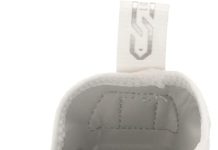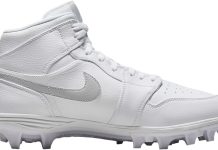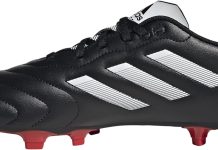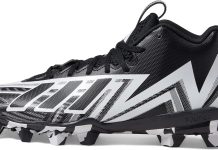In football, the debate rages on whether detachable cleats are better than molded ones.
This seemingly innocuous question has divided players and fans alike, sparking spirited discussions on the pros and cons of each type.
From enhancing traction to providing versatility on different playing surfaces, detachable cleats offer a unique advantage. On the other hand, molded cleats offer stability and a lower risk of injury.
So, which one is truly superior? Join us as we explore the merits of both options and, perhaps, discover the answer to this age-old dilemma.
Benefits of Detachable Cleats
Review contents
Versatility for Different Field Conditions
Detachable cleats offer a significant advantage in versatility, allowing players to adapt to different field conditions effortlessly. Whether you’re playing on a dry grass field, wet, muddy pitch, or artificial turf, detachable cleats provide the flexibility to switch out the studs according to the specific requirements of the playing surface. This means you can easily adjust your traction based on the field conditions, ensuring optimal performance and reducing the risk of injuries.
Customizable Traction
One of the standout benefits of detachable cleats is the ability to customize your traction. With a wide selection of studs available, you can choose the length and shape of the cleats to suit your playing style and the field conditions. For instance, longer studs provide better grip on soft, muddy surfaces, while shorter studs offer improved stability on firm ground. The ability to tailor the traction to your unique needs allows for more control and agility on the field, leading to enhanced performance.
Easy Replacement of Worn Cleats
Detachable cleats also offer the advantage of easy cleat replacement. Over time, the studs on your football boots can wear down due to extensive use. With molded cleats, this would mean replacing the entire pair of boots. However, with detachable cleats, you can replace the worn studs, saving you money and prolonging the lifespan of your boots. This convenience and cost-effectiveness make detachable cleats an appealing choice for players who want to maximize the longevity of their gear.
Benefits of Molded Cleats
Durable and Long-lasting
Molded cleats are known for their durability and long-lasting performance. These designed cleats have superior strength and resilience, making them ideal for players who regularly engage in intense play and challenges. The construction of molded cleats ensures no weak points or detachable parts could break or come loose during a match. Therefore, if you prioritize longevity and robustness in your football boots, molded cleats could be the right choice for you.
Lower Cost
Another advantage of molded cleats is their affordability. Molded cleats are less expensive than detachable ones, making them a more budget-friendly option for players. If you’re starting in football or looking for a more cost-effective alternative, molded cleats offer excellent value for money without compromising performance.
Improved Stability and Performance
Molded cleats provide excellent stability on the field thanks to their fixed stud configuration. The absence of removable studs ensures that your foot stays firmly planted on the ground, reducing the risk of slips, falls, or twisting. With improved stability, you can confidently maneuver around the field, maintaining balance and control while executing precise movements. Molded cleats also offer exceptional traction, allowing you to achieve optimal performance in various playing conditions.
Performance on Different Playing Surfaces
Artificial Turf
Detachable and molded cleats have their advantages when playing on artificial turf. Detachable cleats allow you to adapt the length and style of studs to suit the specific turf type, providing optimal traction and preventing unnecessary slips. On the other hand, molded cleats provide a consistent grip across the entire playing surface, ensuring stability and reducing the risk of injuries. Ultimately, the choice between detachable and molded cleats on artificial turf comes down to personal preference and the specific requirements of the game.
Grass Fields
Both detachable and molded cleats excel on grass fields. Detachable cleats allow for customization of stud length and shape, enabling you to optimize traction based on the firmness of the grass. On the other hand, molded cleats provide reliable grip and stability throughout the game, ensuring you stay firmly grounded whether you prefer detachable cleats’ adaptability or the molded cleats’ steadfastness for excellent performance on grass fields.
Muddy or Wet Conditions
In muddy or wet conditions, detachable cleats have a clear advantage. The ability to change out longer studs for increased traction on soft ground is invaluable when maneuvering through slippery or muddy surfaces. This adaptability reduces the risk of losing footing, helping you maintain stability and perform at your best. Although reliable in most conditions, molded cleats might struggle to provide the same level of traction on extraordinarily wet or muddy fields.
Considerations for Playing Position
Offensive Positions
For players in offensive positions, agility, and quick movement are crucial. Detachable cleats offer the advantage of customizing traction to suit your playing style. Whether you prioritize speed, quick cuts, or sharp turns, being able to adjust the cleat configuration allows for optimal performance and improved acceleration. The versatility of detachable cleats can give offensive players a competitive edge on the field.
Defensive Positions
Players in defensive positions often prioritize stability and reliability in their footwear. Molded cleats offer superior stability due to their fixed stud design. This reduces the risk of slipping or losing traction during critical moments of play, enabling defenders to react swiftly and maintain control. Molded cleats are also known for their durability, ensuring defenders can rely on their footwear to withstand rigorous challenges and unpredictable play.
Special Team Players
Exceptional team players, such as kickers or punters, require a specific type of cleat for their specialized roles. Detachable cleats are particularly advantageous for these players as they can modify their footwear to suit the specific kicking style and field conditions. Adjusting the stud configuration allows exceptional team players to optimize their kicking technique and ensure more accurate performance.
Potential Injuries and Safety
Ankle Injuries
Ankle injuries are a common concern in football, and the choice of cleats can significantly minimize the risk. Both detachable and molded cleats offer ankle support to varying degrees. However, with their solid single-piece construction, molded cleats provide more stability and protection against ankle twists and sprains. If ankle safety is your top priority, molded cleats may be the safer option.
Shoe Stuck Incidents
Another potential safety concern is shoe-stuck incidents, where cleats get caught in the ground when making sudden movements. Detachable cleats are less prone to shoe-stuck incidents as players can adjust the stud length to prevent excessive penetration into the ground. While reliable, molded cleats can occasion cleats finally get caught due to their fixed stud design. Players must consider their playing style and field conditions when assessing the risk of shoe-stuck incidents.
Slipping or Falling
Both detachable and molded cleats provide adequate traction to minimize the risk of slipping or falling. However, the ability to customize stud length and shape gives detachable cleats an edge, ensuring optimal grip on different playing surfaces. Players must consider the field conditions and their playing style when choosing cleats to reduce the chances of slipping and falling during a match.
Regulations and Restrictions
League Guidelines
Football leagues may have specific guidelines regarding the type of cleats allowed on the field. Some leagues may allow detachable and molded cleats, while others may have restrictions or requirements for certain playing surfaces. Players must familiarize themselves with the rules and regulations of their respective leagues to ensure compliance and avoid penalties.
Field Restrictions
In addition to league guidelines, specific football fields may restrict the use of specific cleats. For example, some synthetic turf fields may prohibit using detachable cleats to prevent damage to the playing surface. Players should check with field owners or managers for any restrictions or recommendations regarding cleat types before playing on a particular field.
Referee Requirements
Referees may also have their requirements when it comes to cleats. Some referees may conduct pre-match inspections to ensure players’ cleats are safe and compliant with the rules. Being familiar with the referee’s expectations regarding cleats can help avoid unnecessary conflicts or potential disqualification from the match.
Maintenance and Care
Cleaning and Drying
Proper maintenance of your cleats is essential to ensure their longevity and performance. Regardless of whether you choose detachable or molded cleats, regularly clean and dry your footwear after each use. Remove any excess dirt or debris, and allow them to air dry naturally. Avoid exposing your cleats to extreme heat or sunlight, which can damage the materials.
Storage
When not in use, store your cleats in a cool, dry place to prevent mold or mildew growth. It is advisable to store them in a shoe bag or container to protect them from potential damage and maintain their shape.
Replacement and Repair
Both detachable and molded cleats may require occasional replacement or repair. As mentioned earlier, detachable cleats can quickly replace worn studs. For molded cleats, it is essential to regularly inspect the sole for any signs of wear or damage. CConsulta professional to repair or replace the cleats to ensure continued performance and safety.
Preferred Choice of Professional Players
Real-life Testimonials
Many professional football players have their personal preference when it comes to cleats. Real-life testimonials from these players can provide valuable insights into the performance and benefits of data and molded cleats. Some players may favor detachable cleats for their adaptability, while others may swear by the durability and stability of molded cleats. Considering the experiences and opinions of professionals can help inform your own decision.
Research Studies
Research studies on the performance and safety of different cleats can also shed light on their advantages and disadvantages. These studies may evaluate factors such as traction, stability, and injury rates to provide scientific evidence of the benefits offered by detachable or molded cleats. Keeping up to date with the latest research can assist you in making an informed decision based on objective data.
Impact on Player Performance
Ultimately, the choice of cleats can significantly impact player performance. Factors such as traction, stability, and comfort are crucial in optimizing athletic ability and reducing the risk of injuries.
Professional players understand the importance of finding the right cleats that suit their playing style and the field conditions they regularly encounter. Their preferred choice is often the result of extensive trial and error, as they prioritize the gear that enhances their performance on the field.
Cost Comparison
Initial Investment
When considering the cost, detachable cleats tend to have a higher initial investment than molded cleats. Detachable cleats require the purchase of additional studs to customize traction, which can add to the overall expense. On the other hand, molded cleats offer a more straightforward purchase without the need for additional accessories.
Lifetime Value
In terms of lifetime value, detachable cleats may have an advantage. With the ability to replace worn studs, detaching cleats can extend the footwear’s lifespan, saving you from having to purchase a new pair of boots. Molded cleats, while durable, may require complete replacement once the sole wears down.
Affordability for Amateur Players
For amateur players, cost can be a deciding factor. Molded cleats are generally more affordable, making them accessible to players with a limited budget. However, assessing individual playing needs and preferences is vital as the benefits of detachable cleats may outweigh the initial cost for some players.
Conclusion
The debate over whether detachable cleats are better than molded ones in football ultimately boils down to personal preference, playing style, and specific field conditions. Detachable cleats offer versatility, customizable traction, and easy cleat replacement, making them an attractive option for players seeking adaptability and longevity.
On the other hand, molded cleats provide durability, stability, and affordability, making them a reliable choice for players who value consistent performance. Regardless of the choice, it is essential to prioritize safety, comply with regulations, and care for your cleats properly to ensure a successful and enjoyable football experience.










































